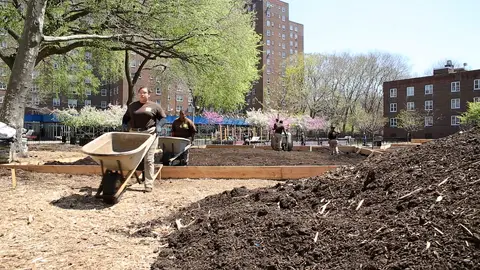Commentary: When Bouncing Back Isn’t Enough

The one-year anniversary of Superstorm Sandy last month spurred renewed conversation about making communities more resilient in the face of extreme weather and disasters. President Obama moved the conversation from talk to action by signing an executive order requiring all federally funded projects to address the impact of global warming, and creating a task force of state and local leaders who will help shape climate resilience efforts.
These are important measures, because we know that even if we act now to combat the worst effects of climate change, we’ll still see an increase in hurricanes, floods, wildfires and other disasters.
The idea of resilience is related to the ability of a place or system to “bounce back” after a shock.
Much of the national dialogue on climate resilience revolves around a community’s ability to "bounce back" after a shock. What's absent from this conversation is the fact that while climate change threatens all of us, communities of color and low-income Americans are hit first and worst. And our response to climate issues need to take that into account.
We have to acknowledge that the social, economic and infrastructural stability of a community all help determine how well it will survive a flood, a fire or a hurricane — and that some places simply need more help shoring up these factors.
Because for many Americans, the question is, "Bounce back to what?" If you’re struggling to keep a roof over your head and feed your kids before a storm strikes, the idea of returning to the same situation after the storm isn’t too appealing.
Nationally, African-Americans are at greater risk for displacement from flooding and rising sea levels because they’re more likely to live in coastal areas. African-Americans are also more vulnerable to heat related deaths, which are expected to increase by 90 percent, because they’re more likely to live in inner cities, which are, on average, 10 degrees warmer than non-urban areas.
Our climate response plans should actively fortify communities on the edge, and ensure that they’re moving forward instead of treading water. Vulnerable communities don’t just need funds to create emergency shelters; they need long-term investment in the things that will make them stronger — including public health, economic vitality and social cohesion. We need to find ways to make hard-hit neighborhoods healthier and safer. And it starts with creating good, high-wage, accessible jobs.
The investments we make in climate resilience offer an opportunity to create these jobs, and connect them to folks living on the edge.
Here’s one example. We know that we have to fix and overhaul storm-water infrastructure — we already experience 23,000-75,000 sanitary sewer overflows each year. With the increased risk of floods from climate change, the need is even more urgent. In fact, the EPA has estimated that we need to spend $188.4 billion just to make the basic repairs. But there’s a tremendous opportunity — because that investment will create roughly two million jobs. A study by Cleveland State University showed that fixing sewers and water systems in Ohio would create 31,000 jobs in that state alone.
In fact, local leaders are already addressing the problem. In New York, the Alliance for a Just Rebuild — a coalition of labor unions, faith, community, environmental and policy organizations — is working to ensure that dollars spent rebuilding and repairing damage from Hurricane Sandy create good jobs and fortify vulnerable neighborhoods.
The right climate response will make sure that vulnerable communities do more than just bounce back. It will ensure that they come back stronger, healthier and more prosperous than before. It will fortify them — not just for the next disaster, but for generations to come.
Phaedra Ellis-Lamkins is CEO of Green For All, a national organization working to build an inclusive green economy.
The opinions expressed here do not necessarily reflect those of BET Networks.
BET National News - Keep up to date with breaking news stories from around the nation, including headlines from the hip hop and entertainment world. Click here to subscribe to our newsletter.
(Photo: Courtesy of Green For All)





